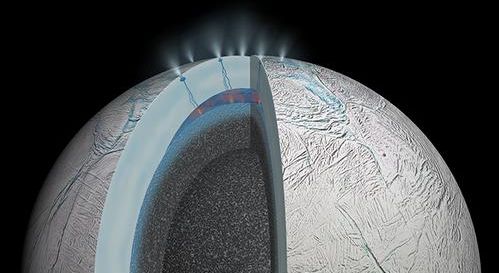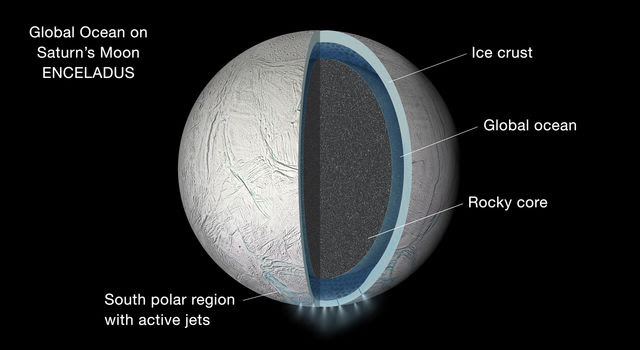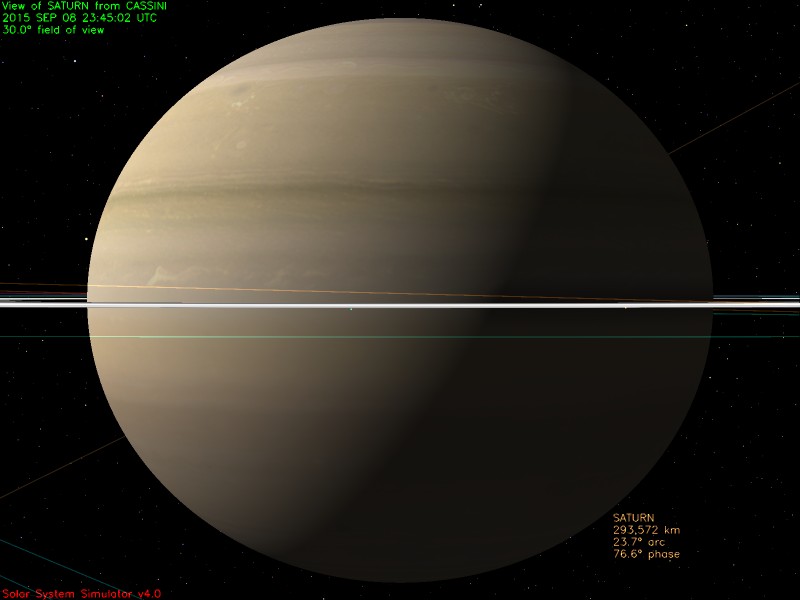New research reveals a global ocean beneath Saturn’s moon Enceladus

Scientists have discovered a global ocean underneath the icy crust of Enceladus, the geologically active Saturn's moon. The discovery has been made by using data from NASA's Cassini mission, NASA announced on September 15, 2015.
Researchers have come to this conclusion by observing the moon's slight wobble it performs during its journey around Saturn. They agreed this very slight wobble can only be explained if Enceladus's outer ice shell is not frozen solid to its interior, which means there must be a global ocean present.

llustration of the interior of Saturn's moon Enceladus showing a global liquid water ocean between its rocky core and icy crust. Thickness of layers shown here is not to scale. Image credit: NASA/JPL-Caltech
This liquid reservoir is likely feeding the fine spray of water vapor, icy particles and simple organic molecules coming from fractures near the moon's south pole.
The research paper presenting the new finding was published in the journal Icarus, as of the week starting on September 14.
The Cassini data at first suggested a presence of a body of water under the moon's south polar region, however the gravity data indicates the sea might be of global character.

Simulated view from the Cassini spacecraft, September 8, 2015. Image credit: NASA/JPL-Caltech
"This was a hard problem that required years of observations, and calculations involving a diverse collection of disciplines, but we are confident we finally got it right," said Peter Thomas, a Cassini imaging team member at Cornell University, Ithaca, New York, and lead author of the paper.
Scientists have analyzed over seven years worth of Enceladus's images provided by the Cassini spacecraft, which has been orbiting Saturn since 2004.
A detailed analysis revealed a small, but measurable wobble on Enceladus's journey around Saturn. The giant planet subtly rocks its moon back and forth, as it's not perfectly spherical in shape and its speed slightly increases or decreases depending on the moon's position on its orbit around Saturn.
The wobble was named 'libration', and the research team has incorporated it into various models of possible Enceladus's interior composition.
"If the surface and core were rigidly connected, the core would provide so much dead weight the wobble would be far smaller than we observe it to be. This proves that there must be a global layer of liquid separating the surface from the core," said Matthew Tiscareno, a Cassini participating scientist at the SETI Institute, Mountain View, California, and a co-author of the paper.
If it is indeed the case that a global ocean is lurking underneath the moon's surface, it's still a mystery why it hadn't frozen over. There is a possibility that tidal forces due to Saturn's gravity could be generating much more heat than previously thought. However, a further study will be necessary to find the missing answers.
"This is a major step beyond what we understood about this moon before, and it demonstrates the kind of deep-dive discoveries we can make with long-lived orbiter missions to other planets," explained co-author Carolyn Porco, Cassini imaging team lead at Space Science Institute, Boulder, Colorado, and visiting scholar at the University of California, Berkeley. "Cassini has been exemplary in this regard."
Discoveries related to Enceladus represent a victorious outcome of Cassini's long mission at Saturn. In early 2005, the signs of moon's icy plume were first detected and the discovery was followed by a series of discoveries afterwards, including the uncovering of material gushing from warm fractures near the moon's south pole. These discoveries suggested the existence of a regional sea in 2014, and hydrothermal activity on the ocean floor, later in 2015.
Cassini spacecraft will make another close flyby of Enceladus on October 28, 2015 and pass only 49 kilometers (30 miles) above the moon's surface which is set to be the deepest dive through the moon's active plume of icy material so far.
Source: NASA/Jet Propulsion Laboratory
Featured image: Possible hydrothermal activity on Enceladus, Artist's impression, March 11, 2015. Image credit: NASA/JPL-Caltech

Commenting rules and guidelines
We value the thoughts and opinions of our readers and welcome healthy discussions on our website. In order to maintain a respectful and positive community, we ask that all commenters follow these rules:
We reserve the right to remove any comments that violate these rules. By commenting on our website, you agree to abide by these guidelines. Thank you for helping to create a positive and welcoming environment for all.